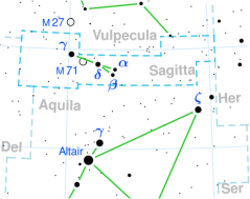Astronomy:Beta Sagittae
| Observation data Equinox J2000.0]] (ICRS) | |
|---|---|
| Constellation | Sagitta |
| Right ascension | 19h 41m 02.93907s[1] |
| Declination | +17° 28′ 33.7528″[1] |
| Apparent magnitude (V) | 4.38[2] |
| Characteristics | |
| Spectral type | G8 IIIa CN 0.5[3] |
| U−B color index | +0.89[4] |
| B−V color index | +1.05[4] |
| R−I color index | +0.50[4] |
| Astrometry | |
| Radial velocity (Rv) | −22.0±0.3[5] km/s |
| Proper motion (μ) | RA: 7.682 ± 0.258[6] mas/yr Dec.: −32.987 ± 0.279[6] mas/yr |
| Parallax (π) | 7.7237 ± 0.1941[6] mas |
| Distance | 420 ± 10 ly (129 ± 3 pc) |
| Absolute magnitude (MV) | −1.39+0.22 −0.20[7] |
| Details | |
| Mass | 4.33[8] M☉ |
| Radius | 27±3[9] R☉ |
| Luminosity | 392[10] L☉ |
| Surface gravity (log g) | 2.79[7] cgs |
| Temperature | 4,850[7] K |
| Metallicity [Fe/H] | –0.03[7] dex |
| Rotational velocity (v sin i) | 9.1±0.7[7] km/s |
| Age | 129[11] Myr |
| Other designations | |
| Database references | |
| SIMBAD | data |
Beta Sagittae, Latinized from β Sagittae, is a single[13] star in the northern constellation of Sagitta. It is a faint star but visible to the naked eye with an apparent visual magnitude of 4.38.[2] Based upon an annual parallax shift of 7.7237 mas as seen from the Gaia satellite, it is located 420 light years from the Sun. The star is moving closer to the Sun with a radial velocity of −22 km/s.[5]
This is an evolved red giant[11] with a stellar classification of G8 IIIa CN 0.5.[3] The suffix notation indicates a mild overabundance of the cyanogen molecule in the spectrum. Beta Sagittae is an estimated 129 million years old with 4.33 times the mass of the Sun,[8] and has expanded to roughly 27 times the Sun's radius.[9] The star is radiating 392[10] times the Sun's luminosity from its enlarged photosphere at an effective temperature of 4,850 K.[7]
Naming
In Chinese, 左旗 (Zuǒ Qí), meaning Left Flag, refers to an asterism consisting of β Sagittae, α Sagittae, δ Sagittae, ζ Sagittae, γ Sagittae, 13 Sagittae, 11 Sagittae, 14 Sagittae and ρ Aquilae. Consequently, the Chinese name for β Sagittae itself is 左旗二 (Zuǒ Qí èr, English: the Second Star of Left Flag.)[14]
References
- ↑ 1.0 1.1 Van Leeuwen, F. (2007), "Validation of the new Hipparcos reduction", Astronomy and Astrophysics 474 (2): 653–664, doi:10.1051/0004-6361:20078357, Bibcode: 2007A&A...474..653V.
- ↑ 2.0 2.1 Fernie, J. D. (May 1983), "New UBVRI photometry for 900 supergiants", Astrophysical Journal Supplement Series 52: 7–22, doi:10.1086/190856, Bibcode: 1983ApJS...52....7F.
- ↑ 3.0 3.1 Keenan, Philip C.; McNeil, Raymond C. (1989), "The Perkins catalog of revised MK types for the cooler stars", Astrophysical Journal Supplement Series 71: 245, doi:10.1086/191373, Bibcode: 1989ApJS...71..245K.
- ↑ 4.0 4.1 4.2 Hoffleit, D.; Warren, Jr., W. H., The Bright Star Catalogue (5th Revised Ed. (Preliminary Version) ed.), CDS. HR 7488, database entry
- ↑ 5.0 5.1 Gontcharov, G. A. (November 2006), "Pulkovo Compilation of Radial Velocities for 35495 Hipparcos stars in a common system", Astronomy Letters 32 (11): 759–771, doi:10.1134/S1063773706110065, Bibcode: 2006AstL...32..759G.
- ↑ 6.0 6.1 6.2 Brown, A. G. A. (August 2018). "Gaia Data Release 2: Summary of the contents and survey properties". Astronomy & Astrophysics 616: A1. doi:10.1051/0004-6361/201833051. Bibcode: 2018A&A...616A...1G. Gaia DR2 record for this source at VizieR.
- ↑ 7.0 7.1 7.2 7.3 7.4 7.5 Carney, Bruce W. et al. (March 2008), "Rotation and Macroturbulence in Metal-Poor Field Red Giant and Red Horizontal Branch Stars", The Astronomical Journal 135 (3): 892–906, doi:10.1088/0004-6256/135/3/892, Bibcode: 2008AJ....135..892C.
- ↑ 8.0 8.1 Liu, Y. J. et al. (April 2014), "The Lithium Abundances of a Large Sample of Red Giants", The Astrophysical Journal 785 (2): 12, doi:10.1088/0004-637X/785/2/94, 94, Bibcode: 2014ApJ...785...94L.
- ↑ 9.0 9.1 Van Belle, G. T. et al. (2009), "Supergiant temperatures and linear radii from near-infrared interferometry", Monthly Notices of the Royal Astronomical Society 394 (4): 1925, doi:10.1111/j.1365-2966.2008.14146.x, Bibcode: 2009MNRAS.394.1925V.
- ↑ 10.0 10.1 McDonald, I. et al. (2012), "Fundamental parameters and infrared excesses of Hipparcos stars", Monthly Notices of the Royal Astronomical Society 427 (1): 343–357, doi:10.1111/j.1365-2966.2012.21873.x, Bibcode: 2012MNRAS.427..343M.
- ↑ 11.0 11.1 Takeda, Yoichi; Tajitsu, Akito (2014), "Spectroscopic study on the beryllium abundances of red giant stars", Publications of the Astronomical Society of Japan 66 (5): 91, doi:10.1093/pasj/psu066, Bibcode: 2014PASJ...66...91T.
- ↑ "bet Sge". SIMBAD. Centre de données astronomiques de Strasbourg. http://simbad.u-strasbg.fr/simbad/sim-basic?Ident=bet+Sge.
- ↑ Eggleton, P. P.; Tokovinin, A. A. (September 2008), "A catalogue of multiplicity among bright stellar systems", Monthly Notices of the Royal Astronomical Society 389 (2): 869–879, doi:10.1111/j.1365-2966.2008.13596.x, Bibcode: 2008MNRAS.389..869E.
- ↑ (in Chinese) AEEA (Activities of Exhibition and Education in Astronomy) 天文教育資訊網 2006 年 7 月 3 日
 |


